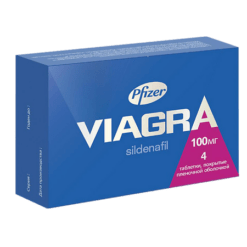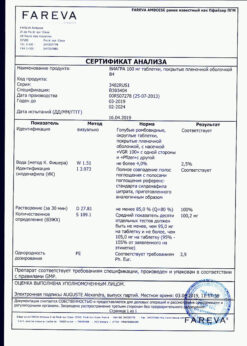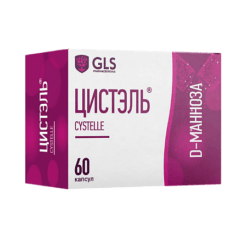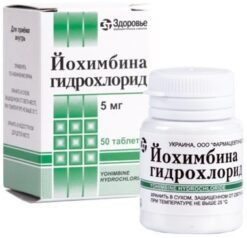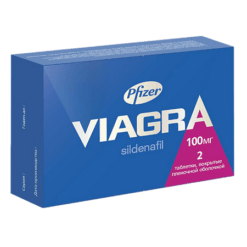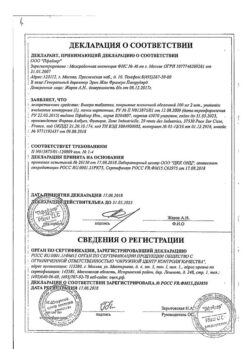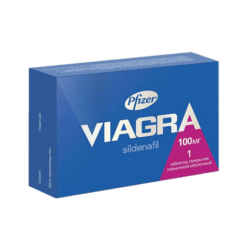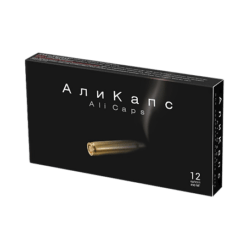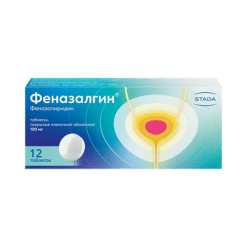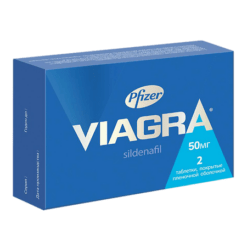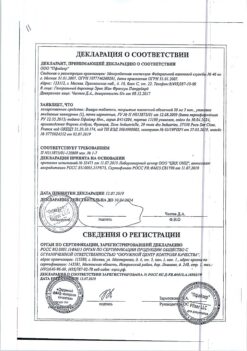No products in the cart.
Urotol, 1 mg 56 pcs.
€22.41 €18.67
Out of stock
(E-mail when Stock is available)
Description
Both tolterodine and its 5-hydroxymethyl derivative are highly specific for muscarinic receptors, competitively block m-cholinoreceptors with the highest selectivity for bladder receptors (in comparison with salivary gland receptors).
The drug decreases tone of the smooth muscles of the urinary tract, detrusor contractile activity and also decreases salivation.
In doses higher than the therapeutic ones, it causes incomplete emptying of the bladder and increases the amount of residual urine. The therapeutic effect of Tolterodin is achieved after 4 weeks. Tolterodine does not inhibit CYP2D6, 2C19, WA4 or 1A2.
Pharmacokinetics
Intake
After oral administration, Tolterodine is rapidly absorbed from the gastrointestinal tract (GIT). Maximum concentration (Cmax) in serum is reached after 1-2 hours. In the range of therapeutic doses (1-4 mg) there is a linear dependence between the value of Cmax in blood serum and the dose of the drug.
The absolute bioavailability of Tolterodin is 65% in those with CYP2D6 deficiency and 17% in most patients.
Food has no effect on the bioavailability of the drug, although the concentration of Tolterodin is increased when it is taken with food.
Distribution
Tolterodine and the 5-hydroxymethyl metabolite bind primarily to orosomucoid. The unbound fractions are 3.7% and 36%, respectively.
Due to the difference in binding to the proteins of tolterodine and 5-hydroxymethyl metabolite the area under “concentration-time” curve (AUC) of tolterodine in persons with CYP2D6 deficiency is close to the sum of AUC values of tolterodine and 5-hydroxymethyl metabolite in most patients with the same dosing regime. Consequently, safety, tolerability and clinical effect of the drug do not depend on CYP2D6 activity.
Metabolism
Tolterodine is primarily metabolized in the liver by the polymorphic enzyme CYP2D6 to form the pharmacologically active 5-hydroxymethyl metabolite, which is then metabolized to 5-carboxylic acid and N-dealkylated 5-carboxylic acid.
The 5-hydroxymethyl metabolite has pharmacological properties similar to those of tolterodine and in most patients significantly enhances the effect of the drug.
In individuals with reduced metabolism (with CYP2D6 deficiency) tolterodine undergoes dealkylation by CYP3A4 isoenzymes to form N-desalkylated tolterodine, which has no pharmacological activity.
The systemic serum clearance of tolterodine in most patients is about 30 l/h. After drug administration, the half-life (T1/2) of tolterodine is 2-3 h, and the T1/2 of the 5-hydroxymethyl metabolite is 3-4 h. In persons with reduced metabolism, the T1/2 is about 10 h.
Decreased clearance of the parent compound in persons with CYP2D6 deficiency leads to increased concentrations of tolterodine (approximately 7-fold) against undetectable concentrations of the 5-hydroxymethyl metabolite.
Approximately 77% of tolterodine is excreted in the urine and 17% in the feces. Less than 1% of the dose is excreted unchanged and about 4% as a 5-hydroxymethyl metabolite. 5-carboxylic acid and N-desalkylated 5-carboxylic acid are about 51% and 29%, respectively, of the amount excreted in the urine.
Pharmacokinetics in special clinical cases
The AUC value of tolterodine and its active 5-hydroxymethyl metabolite is increased approximately 2-fold in patients with cirrhosis.
The average AUC of tolterodine and 5-hydroxymethyl metabolite is 2 times higher in patients with severe renal impairment (glomerular filtration rate ≤30 ml/min). Plasma levels of other metabolites in these patients are significantly higher (12-fold). The clinical significance of increased AUC of these metabolites is unknown.
Indications
Indications
Hyperreflexia (hyperactivity, instability) of the bladder, manifested by frequent, imperative urges to urinate, frequent urination and/or urinary incontinence.
Active ingredient
Active ingredient
Composition
Composition
Active ingredient:
tolterodine* hydrotartrate 1 mg.
Auxiliary substances:
Microcrystalline cellulose, sodium carboxymethyl starch (type A), colloidal silicon dioxide, sodium stearyl fumarate.
Coating composition:
Hypromellose 2910/5, macrogol 6000, titanium dioxide, talc.
* – The generic international name recommended by the WHO is tolterodine.
How to take, the dosage
How to take, the dosage
The drug is administered orally at 2 mg 2 times/day, regardless of meals. The total dose of the drug may be reduced to 2 mg/day, based on individual tolerability of the preprat.
In impaired hepatic and/or renal function and when concomitant use with ketoconazole or other strong CYP3A4 inhibitors, reduction of the drug dose to 1 mg 2 times/day is recommended.
The effectiveness of therapy should be re-evaluated 2-3 months after the start of treatment.
Interaction
Interaction
Special Instructions
Special Instructions
An organic cause of frequent and imperative urge to urinate should be ruled out before starting treatment.
Women of reproductive age should be treated only if reliable contraception is used.
The safety and effectiveness in children has not been studied at this time.
Impact on ability to drive vehicles and other mechanisms requiring increased concentration
When using the drug, caution should be exercised when driving motor vehicles and engaging in other potentially dangerous activities requiring increased concentration, rapid psychomotor reactions, and good vision (may cause accommodation disorders and decreased psychomotor reactions).
Contraindications
Contraindications
With caution, the drug is prescribed when: marked obstruction of the lower urinary tract because of the risk of urinary retention; increased risk of decreased peristalsis of the GI tract; obstructive GI tract diseases (e.g., gateway stenosis); renal or hepatic insufficiency (daily dose should not exceed 2 mg); neuropathy; hernia of the esophageal diaphragm.
Side effects
Side effects
Immune system disorders: allergic reactions, Quincke’s edema (very rare).
Nervous system disorders: nervousness, impaired consciousness, hallucinations, dizziness, somnolence, paresthesias, headache.
Visual organs: dry eyes, accommodation disorder.
Cardiovascular system: tachycardia, palpitations, arrhythmia (rare).
Digestive system disorders: dry mouth, dyspepsia, constipation, abdominal pain, flatulence, vomiting; rarely – gastroesophageal reflux.
Dermatological reactions: dry skin.
Urinary system disorders: urinary retention.
Others: increased fatigue, chest pain, peripheral edema, bronchitis, weight gain.
Overdose
Overdose
Symptoms: accommodation paresis, mydriasis, painful urge to urinate, hallucinations, severe agitation, convulsions, respiratory failure, tachycardia, prolonged QT interval, urinary retention.
Treatment: gastric lavage, activated charcoal. If hallucinations or severe agitation develop, physostigmine; if convulsions or marked agitation, benzodiazepine anxiolytics; if respiratory failure has developed, AVR, beta-adrenoblockers if tachycardia, bladder catheterization if urinary retention, pilocarpine eye drops if mydriasis is present and/or transfer the patient to a dark room.
Pregnancy use
Pregnancy use
The use of Urotol in pregnancy is possible only if the estimated benefit of therapy for the mother outweighs the potential risk to the fetus.
Because there are no data on excretion of Tolterodin with breast milk, the use of the drug during lactation should be avoided.
Women of childbearing age should use reliable contraception during therapy with Urotol.
Additional information
| Shelf life | 3 years |
|---|---|
| Conditions of storage | In a dry place |
| Manufacturer | Zentiva k.s., Czech Republic |
| Medication form | pills |
| Brand | Zentiva k.s. |
Related products
Buy Urotol, 1 mg 56 pcs. with delivery to USA, UK, Europe and over 120 other countries.


